#Qianlong
Text
Qianlong shouhu Han et al., 2023 (new genus and species)

(Select bones and schematic skeletals of adult [a] and embryonic [b] individuals of Qianlong shouhu, with preserved bones in gray, from Han et al., 2023)
Meaning of name: Qianlong = Qian [alternative name for Guizhou] dragon [in Chinese]; shouhu = guarding [in Chinese]
Age: Early Jurassic (Sinemurian?)
Where found: Ziliujing Formation, Guizhou, China
How much is known: Three partial skeletons of adult individuals and five clutches of 3–16 eggs containing embryos.
Notes: Qianlong was an early sauropodomorph. It is notable not only for the exceptional preservation of its fossils, but also the fact that these specimens appear to be associated with nests, thus offering valuable information on their growth and reproductive behavior. As has also been found for some early sauropodomorphs, such as Massospondylus from the Early Jurassic of Southern Africa and Mussaurus from the Early Jurassic of Argentina, Qianlong appears to have laid its eggs in breeding colonies with adult individuals potentially watching over their nests. Qianlong was additionally similar to these other early sauropodomorph in being bipedal as an adult, but likely quadrupedal as a young juvenile.
Rigid, hard-shelled eggs have been found in multiple groups of dinosaurs, including tetanuran theropods (such as birds), hadrosaurids (duck-billed dinosaurs), and titanosaurian sauropods, as well as their closest living relatives, the crocodylians. As a result, it was long assumed that all dinosaurs probably laid hard-shelled eggs. However, recent evidence has suggested that the eggs of early dinosaurs may have instead had flexible, leathery shells, more similar to those of most lizards and some turtles, with rigid eggshells evolving several times in later dinosaur groups. The eggshells of Qianlong appear to have been leathery in structure, lending support to this hypothesis.
Reference: Han, F., Y. Yu, S. Zhang, R. Zeng, X. Wang, H. Cai, T. Wu, Y. Wen, S. Cai, C. Li, R. Wu, Q. Zhao, and X. Xu. 2023. Exceptional Early Jurassic fossils with leathery eggs shed light on dinosaur reproductive biology. National Science Review advance online publication. doi: 10.1093/nsr/nwad258
143 notes
·
View notes
Text
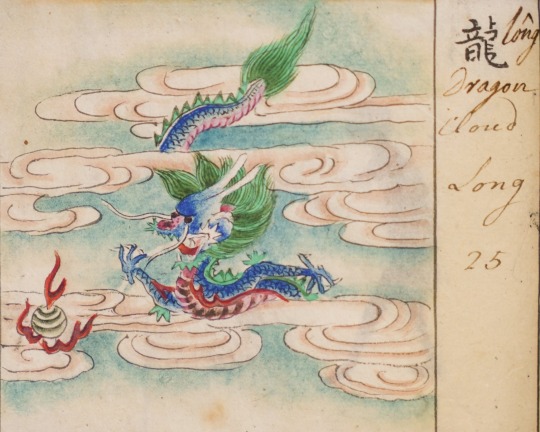
30 notes
·
View notes
Text
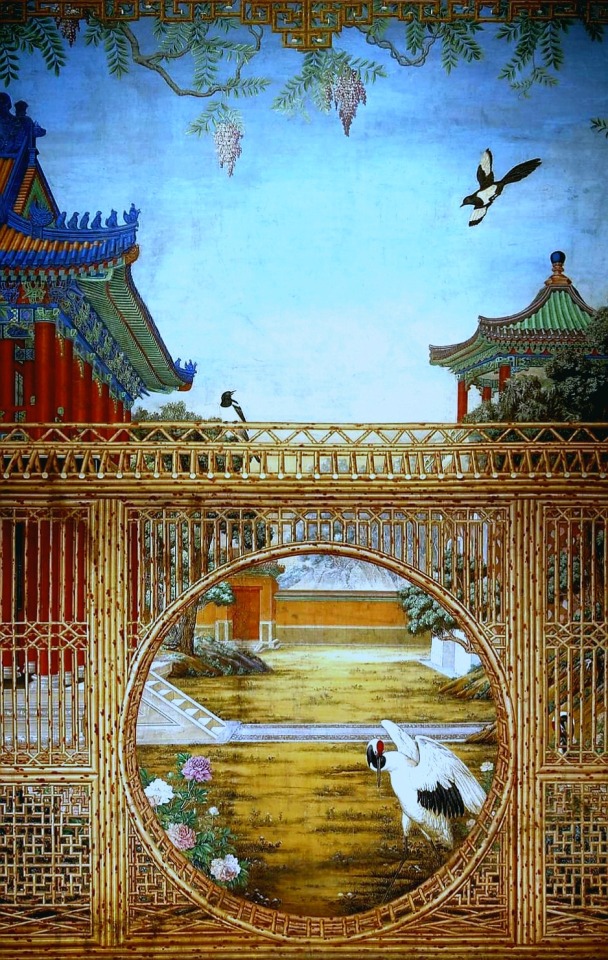

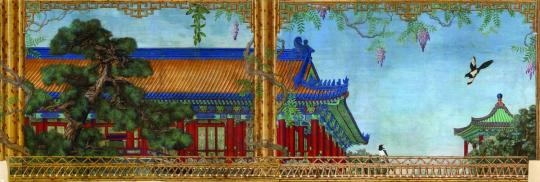
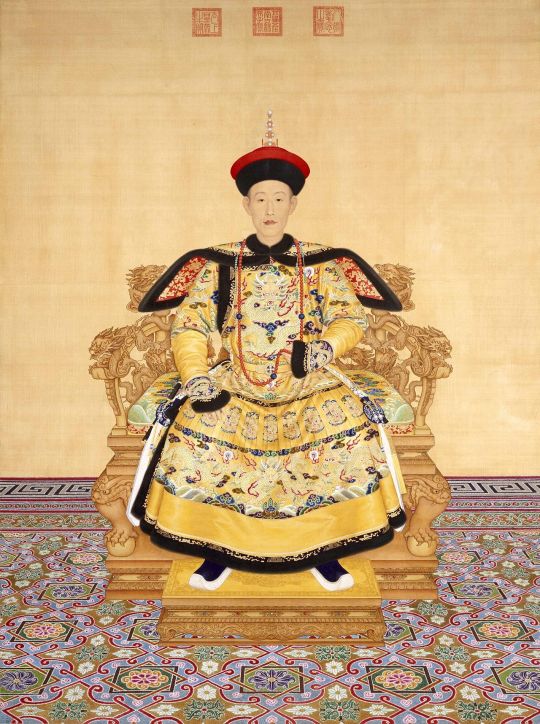

Giuseppe Castiglione (Italian Jesuit missionary and court painter, 1688 - 1766), a.k.a. Láng Shìníng, Qianlong, Emperor of Qing dynasty (reigned 1735-96).
youtube
The Emperor's Secret Garden
#giuseppe castiglione#qianlong#ch'ien-lung#chundi#forbidden city#beijing#china#magpies#manchurian crane#red crowned crane#Youtube#chinese history
37 notes
·
View notes
Note
Hitting you up because I want to hear more about Emperor Qianlong's art collection! My two big all-consuming hobbies are drawing and reading about history, so I pretty much can't get enough of either topic
OH OH where to BEGIN with Qianlong and his love of the arts???? And also okay he historically is SUCH a funky guy idk where to even begin on how much I love cool and kind of failflop Qianlong facts. If you want to know about his hilarious terrible poetry I leave you with this poem he wrote about cucumbers:
It is the best ingredient on the plate in Beijing;
I tasted it lately in February, but how can I give it a review?
Weighing down the trellis, and embellishing the fence, it looks so beautiful,
The rural landscape contains true feelings.
No this isn’t any better in Chinese. You can find it and other Qianlong poetry roasts here.
Okay, I don’t know if Qianlong’s art collection/paintings created for him can be contained in a single answer, BUT, I’ll do my best!
Emperor Qianlong was an avid patron of the arts, and his collection of paintings, jade pieces, and other antiques remain one of the greatest reasons why we still have a lot of the pieces on display around the world today. He was also in the habit of writing on/stamping his personal seal on his favorite paintings and art pieces, and some of these repeatedly viewed paintings (with his notes/thoughts/writings) also preserve great portions of his life, which is a really intimate look into him as a person especially throughout time. We rarely get this sort of information from a ruler since MOST imperial writing has been edited/was meant to present to other people. He also liked to take landscape paintings with him on his travels to compare the landscapes in the paintings to their irl presentation.
His habit of turning his favorite paintings into diaries is NOT a common practice btw, most people didn’t deface the paintings in their collections. (Okay they might put their personal stamp on it to explain that they own it, but WRITING NEW SHIT ON IT? nah.)
Art historians, btw, have been in argument about his practice of defacing paintings and basically being in conversation with them ON the painting itself, since practically the time he started doing this about if it’s destroying the art or enhancing it somehow. He was just. SUCH a guy.
(He uh, may also have used coercion, threats, and force to acquire some of these because he was the emperor and he wanted them. This behavior was normal for emperors but his obsession with art and antiques was slightly less normal. Like, this man was IN LOVE with art.)
The OTHER hilarious thing about Qianlong was that while he LOVED paintings and antiques and poetry and art he uh, well okay see the above roast re his poetry but he wasn’t very good at any of these things per se. (For example, there are multitudes of stories about how he’d get really happy about a certain painting or antique in his collection, only to discover that it was a GREAT forgery or a fake or not actually all that old and oh here’s the actual thing your majesty this is the real one and be SO embarrassed by this new knowledge that he’d just KEEP BOTH and pretend nothing was wrong. Like just WHAT a guy. What a guy lmao.)
Qianlong also really loved western style paintings and painters. For example, Giuseppe Castiglione was one of his favorite court painters (Chinese Name Lang Shining) and did these two paintings of Emperor Qianlong:
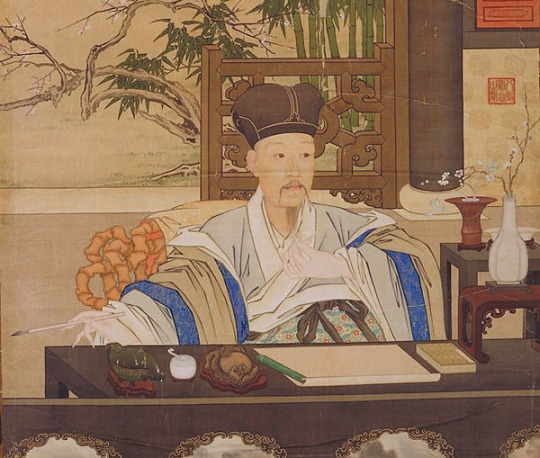
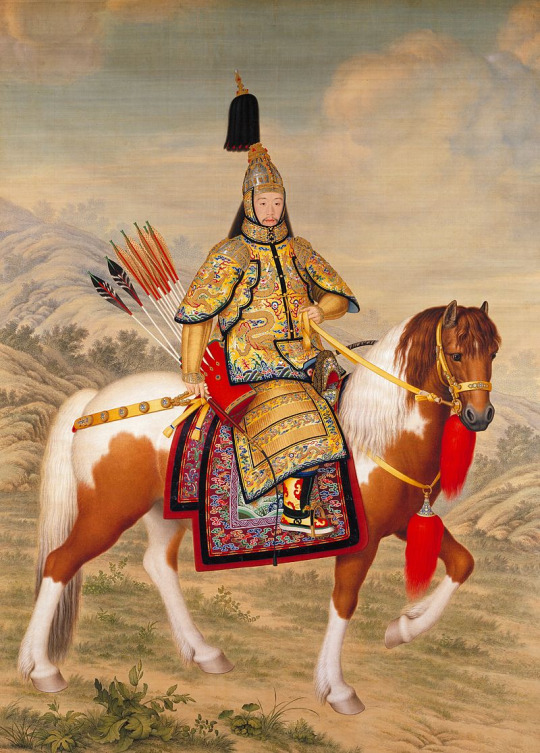
These two paintings are like, some of my favorite things because like, the combination of east and west, and utilization of like, different techniques and perspectives is !!!! in my brain. Like, it’s incredible and I love it so much.
Qianlong also incorporated a lot of western style architectural elements in his redesign and beautification of Yuanmingyuan and had a REALLY interesting life overall, but this is getting kind of long so 😂I’ll leave off for now.
Feel free to ask about anything that sounds interesting about this though! I love to ramble.
#qianlong#asks and answers#history#chinese history#he was just SUCH a guy#if I had historical blorbos this would be a historical blorbo
35 notes
·
View notes
Text
Emperor Qianlong and his influence on the Qing Dynasty
Qianlong (乾隆皇帝) , personal name “HongLi” was born on September 25 of 1711 in Beijing, China.
He was the fourth and favorite son of Emperor Yongzheng and ascended the throne in 1735 and reigned for more than 60 years.
The Emperor had a strong resilient spirit as he excelled both in military campaigns, allowing China to flourish with the chinese empire reaching its peak years during his 60 year reign, but he was also an enjoyer of arts and literature preserving the spirits of his father and grandfather who where both equally invested in this aspect.
During his lifetime he had about 50 consorts and concubines that served him including 3 empresses, 5 imperial noble consorts, 5 noble consorts, 6 consorts, 6 imperial concubines, 12 noble ladies, 4 female attendants, 5 “choice ladies” and 2 GeGe (格格)
the most famous out of all of them was Ula Na’ra (The Empress Nara of the Nara clan) (i will make another post explaining this and getting more in depth with her personal story)
now there are a lot of things i could say about Qianlong but it will be divided into many many parts as the story and dramas are never-ending (why do u think there are so many series based on him ?hahah)
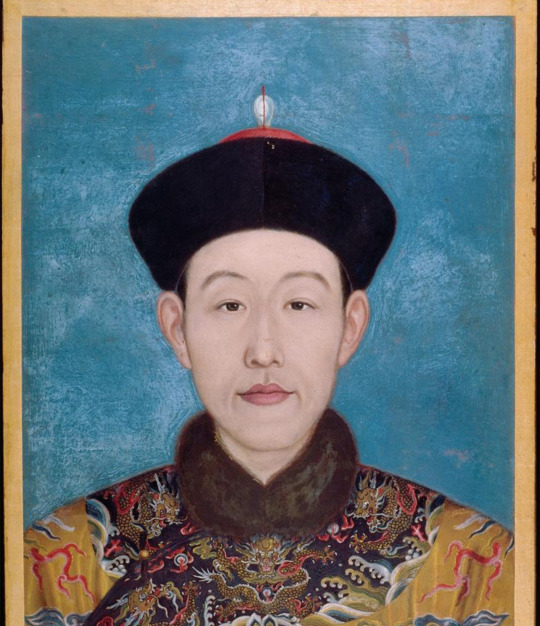

Qianlong

Empress Nara
if u read my previous post you’ll know why she’s wearing three earrings in each ear 😏😙
*fun fact Qianlong is believed to have destroyed all of her portraits so we don’t actually know if this is actually her*
(Chinese equivalent of Anne Boleyn ??)
#china#chinese history#history#qing dynasty#education#language#qianlong#qing#ancient china#18th century
3 notes
·
View notes
Text

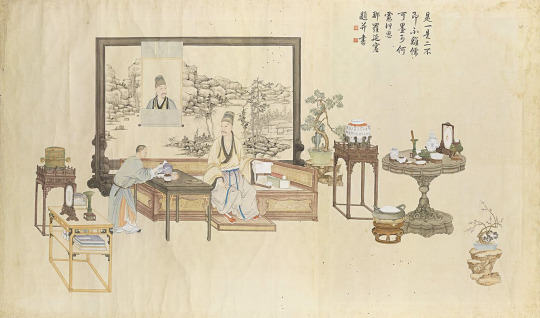

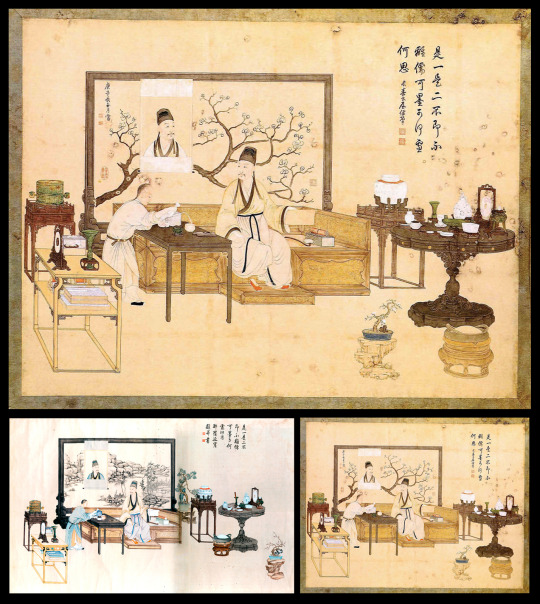
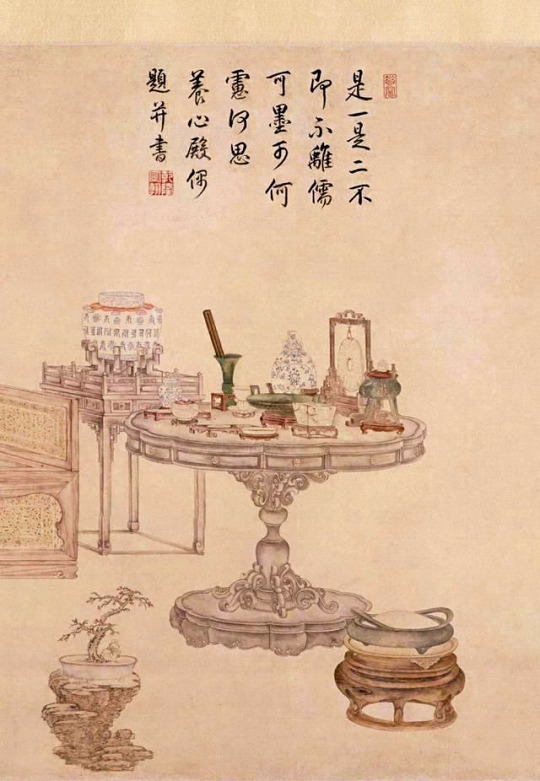
Qianlong Emperor’s Penzai Trees-
The Qianlong emperor was especially skilled with sword, brush, and bow. He was also quite the art connoisseur, amassing a unique collection during his lifetime. These two versions of this painting of the emperor with some of his treasures both include Chinese Penzai (better known by the Japanese term for these trees, Bonsai).
What I find most interesting, is that these Chinese Penzai trees are quite similar in feel to Japanese Bonsai. Judging from the fair number of contemporary Chinese Penzai I encountered on my many trips around China, one has the impression that the Chinese approach to this art is one where the tree are generally fuller, with more foliage. That does not appear to be the case for Penzai styled during the Qing period.
It is also interesting to note that while Penzai does not appear to have been as popular in Imperial China as it was in Japan during the same period, these trees were still treasured by some literati.
#penzai#penjing#bonsaipenjing#bonsai#swordsmanbonsai#scottmrodell#scottrodell#bonsaitree#qianlong#qingdynasty#qingpenzai
7 notes
·
View notes
Text
The amount of dropkick and beating that Ruyi!Qianlong launched on his wives and sons (and servants in Yanxi!Qianlong) make me wondering if IRL!Qianlong really loves martial art (and eating since I found at least two food recipes being approved by him)
And yes I guess? I found this 😂😂

3 notes
·
View notes
Text

"Vase Couvert en Ambre" de la Dynastie Qing, époque Qianglong (1711-99) à l'exposition "Ambre, Trésors de la Mer Baltique du XVIe au XVIIIe siècle" à la Galerie Kugel, Paris, décembre 2023.
2 notes
·
View notes
Text

Qianlong Emperor at Full Draw. Interesting to note the length of the fletching. During the 18th century, the fletching on Manchu arrows easily fit within the brace height.
#manchurian#qingdynasty#qianlong#manchuarchery#manchuarcher#traditionalarchery#chinesearcher#chinesearchery#traditonalarchery#bannerman#manchubannerman
1 note
·
View note
Text
1788: Chinese Ghost Stories from "What Confucius Would Not Discuss"
From Twitter feed at Jakabfi Károly (霸王最忠之臣子)
A ghost story collection was the top of a recent Twitter note by the Hungarian student of China Jakabfi Károly (霸王最忠之臣子) Károly has the parenthetical Twitter Chinese moniker ‘the most loyal minister of the hegemon’ – keep in mind hegemons 霸王 weren’t necessarily bad guys back in ancient China: Confucius and Mencius spoke well of them if they were good…

View On WordPress
#Ch&039;ing#China#dream#epidemic#folk tale#folklore#ghost#Hell#horror#Kangxi#magistrate#popular#popular literature#Qianlong#Qing#Religion#soul#spirit#tale#underworld#Yongzheng#Yuan Mei#中国
0 notes
Photo
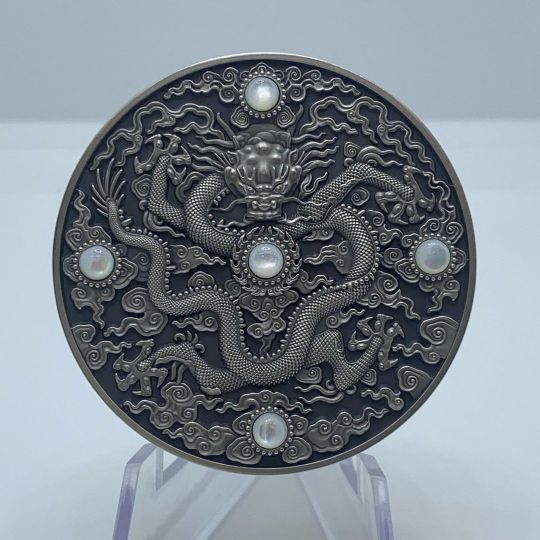
L’imperatore cinese #qianlong fu il quarto della dinastia cinese #Qing. Visse per 87 anni e regnò per oltre 60 anni, uno dei periodi più lunghi della storia cinese. Niue 🇳🇺 2023: 5 $ Dragon art - Qing dynasty. Metal: Ag 999%; Weight: 62.2 grams; Diameter: 50 mm; Features: mother of pearl inlay and 3D high relief; Mintage: only 200 pcs numbered! (presso Numismatica Castaldi) https://www.instagram.com/p/CpfDyrEKJpC/?igshid=NGJjMDIxMWI=
0 notes
Text

Snuff Bottle. Chinese origin, made during the Qianlong reign period (1736–1795) of the Qing Dynasty (1644–1911). Medium is pink glass with white and black overlay. Dimensions: h. 7.3 cm x w. 6.0 cm x d. 2.8 cm. From the Princeton University Art Museum, object number: y1936-539.
(Source: artmuseum.princeton.edu)
#bottle#vessels#1700s#18th century#qianlong period#qing dynasty#chinese design#animal motif#horses#glass#pink#white
256 notes
·
View notes
Text
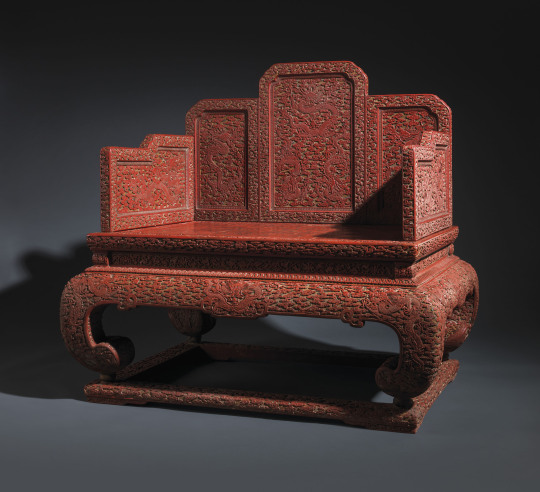




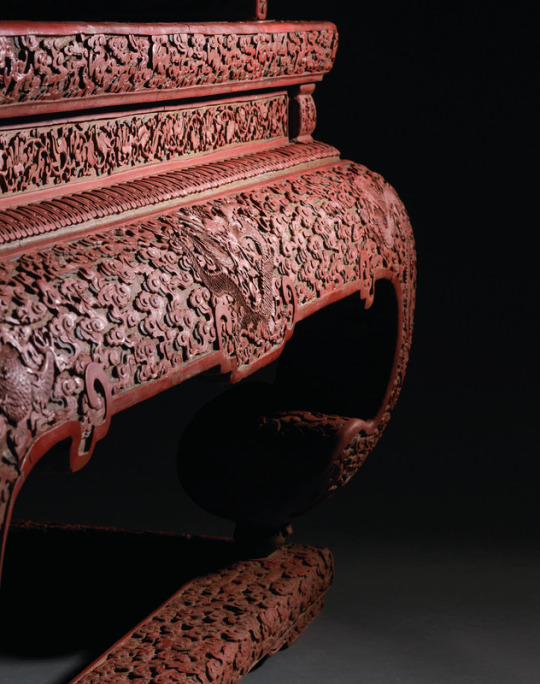

Imperial three-colour carved ‘Nine Dragon’ lacquer throne,
Qianlong period (1736-1795).
The throne is finely carved through the red lacquer to the ochre and dark green lacquer and has a stepped back separated into three vertical panels each containing dragons chasing flaming pearls amidst dense clouds.
The two side railings are similarly carved in high-relief with dragons striding amidst bats in flight and dense scrolling clouds above a rectangular seat decorated with archaistic lotus scroll and a narrow waist with a shaped apron centred with a front-facing dragon.
The back panel is carved with a bat suspending a chime and a double-fish. The whole is raised on thick rounded legs joined by rectangular base stretchers.
43¼ x 45½ x 33¾ in (111.1 x 115.5 x 85.7 cm)
Courtesy: Christie's
#art#history#design#style#sculpture#antiquity#christie's#throne#china#laquered#millwork#dragon#happy year of the dragon!#happy lunar year 2024#happy lunar new year#imperial#qianlong dynasty
86 notes
·
View notes
Photo

(#3034) A FINE AND RARE LIME-GROUND FAMILLE-ROSE TEAPOT AND COVER SEAL MARK AND PERIOD OF QIANLONG
922 notes
·
View notes
Photo


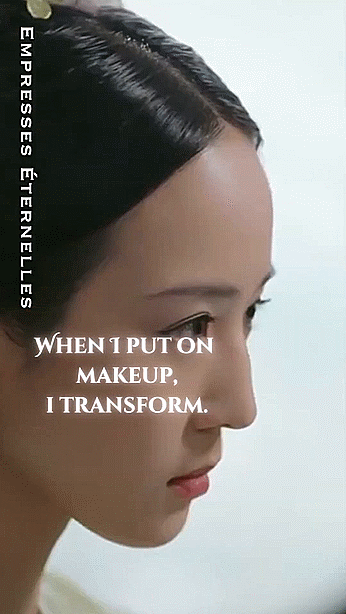

Cdrama: Ruyi’s Royal Love in the Palace (2018)
Hailan "When I put on makeup, I transform" | Ruyi's Royal Love in the Palace 如懿传 (Eng Sub)
Watch this video on Youtube: https://www.youtube.com/shorts/t6-W_O-iMFs
#Ruyi's Royal Love in the Palace#如懿传#Ru Yi Zhuan#Inner Palace#Legend of Ruyi#2018#Tencent#QQlive#cdrama#chinese drama#youtube#shorts#short video#Zhou Xun#Ulanara Ruyi#Wallace Huo#Huo Jian Hua#Emperor Qianlong
92 notes
·
View notes
Text
Abridged History of Qing Dynasty Han Women’s Fashion (part 5: Late Qianlong & Jiaqing eras)

(artwork from 1782)
Previous posts:
Late Ming & Shunzhi era
Kangxi era
Late Kangxi & Yongzheng eras
Qianlong era
The last two decades of the Qianlong era, the 1780s and 90s, formed one aesthetic continuity with the reign of Qianlong’s successor Jiaqing (1796-1820). This period was characterized by a turn to extreme formal simplicity and what I believe to be a revival of the tastes of the Ming-Qing transition.
We see sleeves of women’s robes, tight fitting and short to create a practical look in the previous era, become wider and longer. The folded cuff design was retained, though now more difficult to manage as the sleeves became wider. In the last post I discussed how the construction of dajin similar to Manchu men’s fashion became en vogue among Han women and replaced the earlier center front closing robes----this remained the same. We see some of the first instances of binding strips being used around the collar and the dajin, which would become a highly popular and elaborate craft later in the 19th century. Around this time, the binding strips used were usually thin and minimal, commonly of a black color. Plain cloth or bead tip buttons were popularized earlier in the Qianlong era, and metal clasp buttons (zimukou) became increasingly rare. The shape of the standing collar remained the same as that of previous centuries, soft, unstiffened and tall.
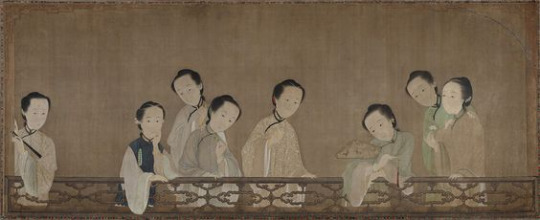
Artwork from 1796 showing a group of courtesans. You can see the black binding on some of their robes. A note about the dating of this artwork: while it’s quite a common reference image for Jiaqing era fashion, I wasn’t able to find an exact date until I read about it in the book Pictures for Pleasure and Use by James Cahill (spectacular book discussing the importance of vernacular and commercial art, highly recommend) and he said the date of creation was signed in the cyclical calendar and corresponds to either 1736 or 1796. He was inclined to 1736 because of “similar face shapes” or something to Yongzheng era artworks, but since he wasn’t a fashion historian he probably wasn’t aware that the fashions depicted here would not have been possible before the 1780s, so I think 1796 is instead the correct date.
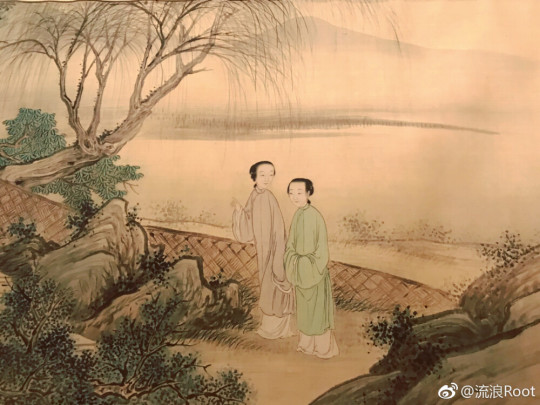
Late Qianlong/early Jiaqing era artwork, showing two austerely (and fashionably) dressed women.
The more radical departure from the previous era, however, was the complete eradication of ornament. Robes and skirts of this era were often entirely plain, with no brocaded patterns or embroidery of any kind. Gone were the roundel patterns, quatrefoil motifs on collar facings and decorative strips around skirts----only solid color blocks remained. Pastel colors like light pink, blue and green were among the most popular for robes besides bright blue and red, whereas skirts were white or black.

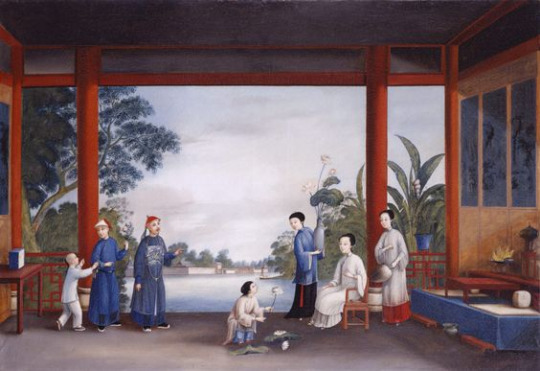
Late Qianlong/early Jiaqing era paintings of the Anglo-Chinese school showing the new style of plain garments.

Artwork from the era showing a woman in a light mustard robe with dusty pink cuffs, white skirt and red sash (sashes were still commonly worn).
The other significant changes happened in hairstyling. The 1780s did away with the iconic tall knots of the earlier Qianlong era, instead moving the mass and volume of hair toward the back. We see the re-emergence of the swallow tail. The front of the hair could be middle parted or completely pulled back. Flowers and other ornaments could be worn on the sides of the hairdo, behind the ears. The general shape of hairstyles stressed horizontality rather than verticality, as was the case before.
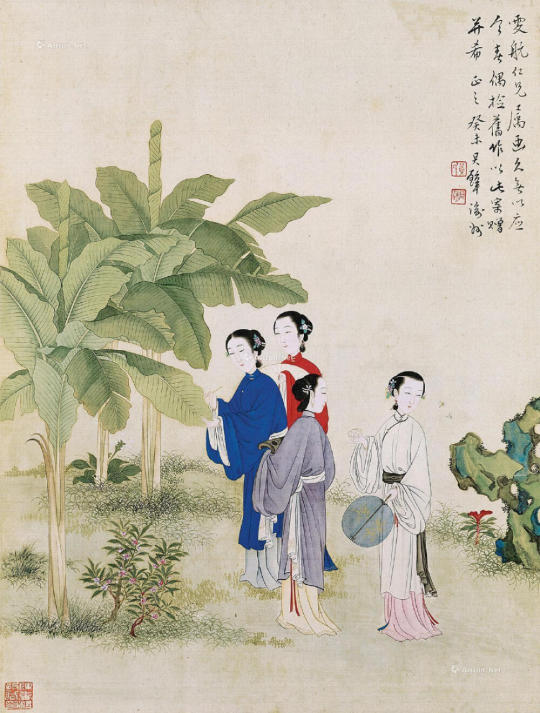
A 1943 copy of a turn of the 19th century original, showing the front and back of hairstyles.

Bust portrait showing the new hairstyle.
A unique hair accessory of the 1780s and 90s was a new iteration of the mo’e, which now had a sharply pointed triangular front and was worn high on the head instead of at the forehead. I think it became less common as the 19th century approached.
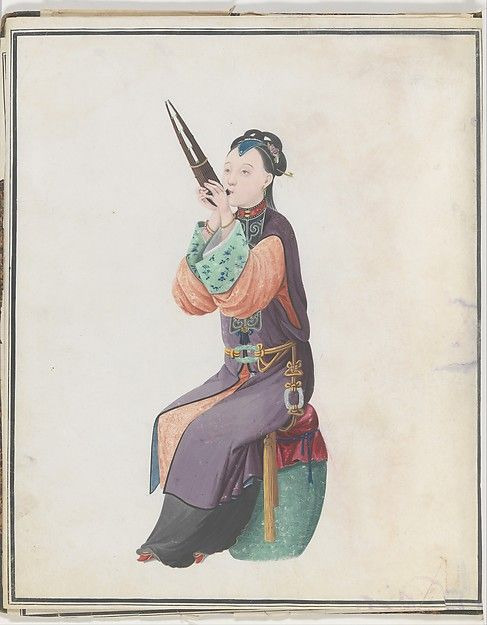
Export artwork showing a woman musician, likely 1770s or 80s as she is still wearing the ornamented, center front closing robes popular in previous decades.
Minimalism was not to last long, however, and soon decorative patterns began to reappear on robes, sleeve cuffs and skirts. Hairstyles began to gain volume and became more puffed, forming a sort of face framing crown. New styles of decorating skirts appeared, with binding going around the qunmen and the edge of each pleat, and embroidery on each individual pleat. The rectangular or circular patterned patch popular prior to the 1780s returned.

Early 19th century export painting at the Brighton Pavilion, maybe 1810s. We can see roundel patterns on the blue robe, embroidery on the cuffs and skirt, and the lady in red wears a pointed mo’e.

Presumably later Jiaqing era artwork, ca. 1810s, showing a group of women. Floral embroidery is present on the sleeve cuffs, the skirts are decorated.
#abridged history of qing dynasty han women's fashion#18th century#19th century#qianlong era#jiaqing era#qing dynasty#chinese fashion#fashion history#regency era
177 notes
·
View notes